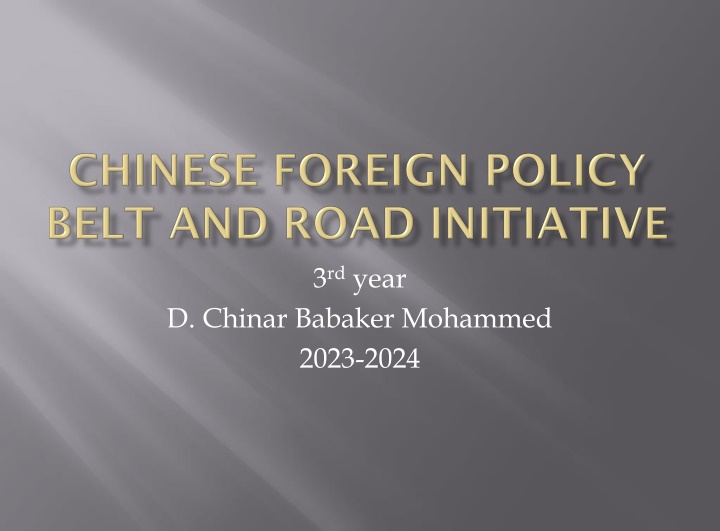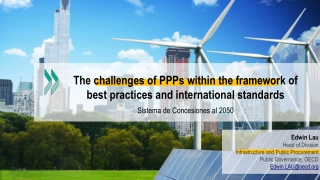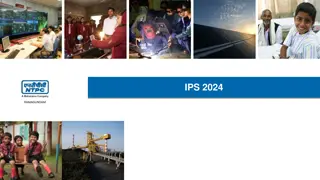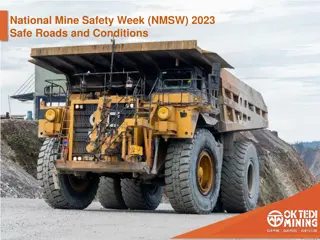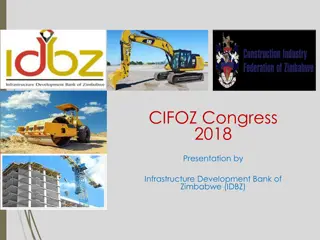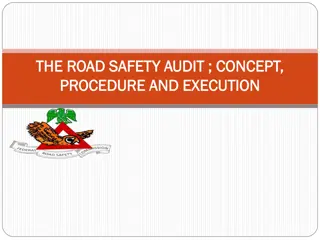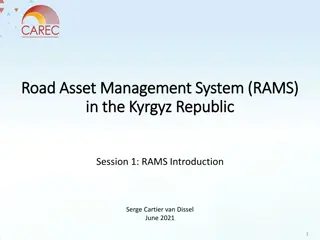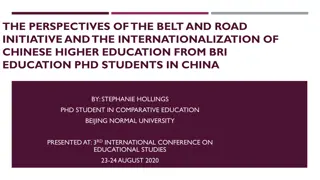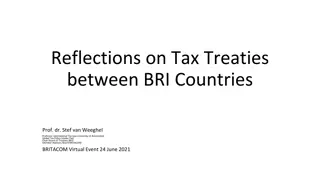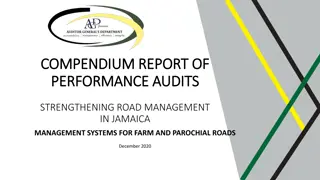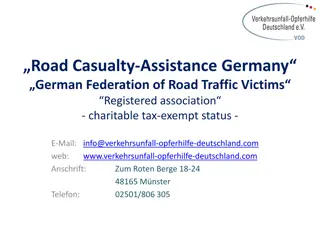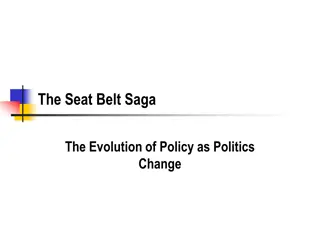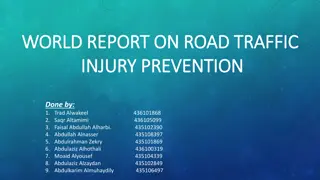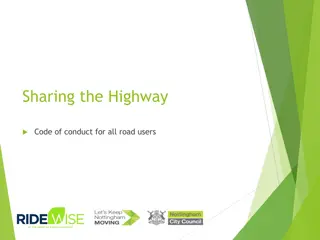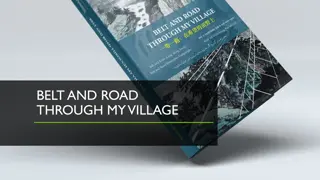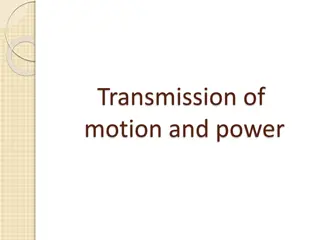Belt and Road Initiative Overview - Connecting Countries Through Infrastructure Development
The Belt and Road Initiative (BRI) is a long-term vision proposed by Xi Jinping to connect over 70 countries across Asia, Eastern Africa, Eastern Europe, and the Middle East through infrastructure development. The project consists of land and maritime corridors, such as the New Eurasian Land Bridge Economic Corridor and the China-Pakistan Economic Corridor, with estimated expenditures reaching trillions by 2027. This initiative aims to enhance economic cooperation and connectivity on a global scale.
Download Presentation

Please find below an Image/Link to download the presentation.
The content on the website is provided AS IS for your information and personal use only. It may not be sold, licensed, or shared on other websites without obtaining consent from the author.If you encounter any issues during the download, it is possible that the publisher has removed the file from their server.
You are allowed to download the files provided on this website for personal or commercial use, subject to the condition that they are used lawfully. All files are the property of their respective owners.
The content on the website is provided AS IS for your information and personal use only. It may not be sold, licensed, or shared on other websites without obtaining consent from the author.
E N D
Presentation Transcript
3rdyear D. Chinar Babaker Mohammed 2023-2024
It is an initiative which has been proposed by Xi Jingping in 2013 summit of the Association South East Asian Nations (ASEAN) At that time was One Belt and One Road (OBOR) But then March 28, 2015 it became Belt and Road Initiative by the National Development and Reform Commission (NDRC)
The project covering the countries in Asia, Eastern Africa, Eastern Europe and the Middle East Till the time the number of countries which participated are 71 countries which are third of the world GDP And two third of the world peoples
The (land based) Silk Road Economic Belt, comprising six development corridors The 21st Century Maritime Silk Road The polar silk
It is long term vision For infrastructure development spanning six development corridors , namely:
1. New Eurasian Land Bridge Economic Corridor (NELBEC) 2. China Mongolia Russia Economic Corridor (CMREC) 3. China Central Asia West Asia Economic Corridor (CCWAEC) 4. China Indochina Peninsula Economic Corridor (CICPEC) 5. Bangladesh China India Myanmar Economic Corridor (BCIMEC) 6. China Pakistan Economic Corridor (CPEC)
China-Pakistan Economic Corridor: Analysts estimate the largest so far to be the estimated $60 billion China-Pakistan Economic Corridor, a collection of projects connecting China to Pakistan s Gwadar Port on the Arabian Sea. In total, China has already spent an estimated $200 billion on such efforts (BRI)
The overall expenses of China for the BRI project could reach to the 1.2-1.3 trillion by 2027
The 21st Century Maritime Silk Road connects China to Southeast Asia, Indonesia, India, the Arabian peninsula, Somalia, Egypt and Europe, encompassing the South China Sea, Strait of Malacca, Indian Ocean, Gulf of Bengal, Arabian Sea, Persian Gulf and the Red Sea.
On January 26, 2018, the State Council Information Office of the People`s Republic of China published a white paper titled China`s Arctic Policy , vowing to actively participating in Arctic affairs. The document is a blueprint for China`s Arctic strategy and its ambition to develop a Polar Silk Road under the Belt and Road Initiative .
The Belt and Road Initiative is project which covering all the route including the maritime 21 century silk road, Land based silk road economic belt and polar silk road This kind of project is regarding the integration of regions under the BRI
1. Policy coordination 2. Facilities connectivity 3. Unimpeded trade 4. Financial integration 5. People-to-people bonds
Policy coordination (Promotion of intergovernmental cooperation, multi-level intergovernmental macro policy exchange and communication mechanism)
Facilities connectivity (Improvement of connectivity of infrastructure construction plans and technical standards systems)
Unimpeded trade (Reduction of investment and trade barriers, promotion of regional economic integration)
Financial integration (Coordination and cooperation in monetary policy, set-up of financing institutions) People-to-people bonds (Cultural and academic exchange and dialogue, media cooperation)
To fully fund the total BRI project volume of estimated USD 4 to 8 trillion, diverse funding channels such as BRI bonds, private capital investment and public-private partnerships (PPP) but also State-Owned Enterprise (SOE) investment will be crucial for the success of the Initiative.
It is Chinese economic and political influence Chinese rising power
Hope to achieve two motivations behind BRI Geopolitics motivation Economic motivation
Developing the economies of South and Central Asia is a long-standing U.S. goal that intensified after the start of the U.S.-led war in Afghanistan and President Barack Obama s pivot to Asia
the Obama administration supported a $10 billion gas pipeline through Turkmenistan, Afghanistan, Pakistan, and India.
the United States to deepen its ties with Asian partners, as the Obama administration tried to do with the Trans-Pacific Partnership (TPP), a deal rejected by Trump. The Trump administration has instead tried to counter the BRI with the BUILD Act.
India; India has tried to convince countries that the BRI is a plan to dominate Asia, warning of what some analysts have called a String of Pearls geo- economics strategy whereby China creates unsustainable debt burdens for its Indian Ocean neighbors in order to seize control of regional choke points
Many commentators in India believe this plan (String of Pearls) , together with the China Pakistan Economic Corridor and other parts of China's Belt and Road Initiative under chinese Communist Party general secretary Xi Jingping, , is a threat to India's national security
Japan: Tokyo has a similar strategy, balancing its interest in regional infrastructure development with long- standing suspicions about China. In 2016, Japan committed to spending $110 billion on infrastructure projects throughout Asia. Japan has, with India, also agreed to develop the Asia- Africa Growth Corridor (AAGC), a plan to develop and connect ports from Myanmar to East Africa.
Europe: Some countries are agree with the project like Italy, Luxembourg, and Portugal have signed provisional agreements to cooperate on BRI projects.
FRANCE Is disagree with the project Russia: Moscow has become one of the BRI s most enthusiastic partners, though it responded to Xi s announcement at first with hesitation, worried that Beijing s plans would beat Moscow s vision for a Eurasian Economic Union and influence on its traditional sphere of influence.
https://www.cfr.org/backgrounder/chinas- massive-belt-and-road-initiative https://www.beltroad-initiative.com/belt-and- road/
